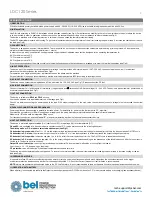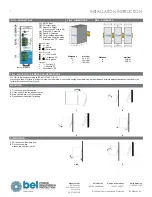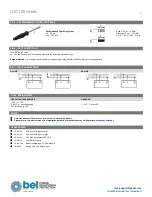
LDC120 Series
2
USER INSTRUCTIONS
1) DESCRIPTION
DIN rail mountable primary switched-mode power supply with 90 - 264 VAC (110 - 345 VDC) input, suitable for single phase mains line and DC line.
2) INSTALLATION
Use DIN-rails according to EN60715. Installation should be made vertically (see Fig.4). For better device stability fix the rail to the wall close to the point where the device
is to be mounted. In order to guarantee sufficient convection, we recommend observing a minimum distance to other modules (see Fig.3).
The device is provided with a thermal protection; a limited air flow can cause the thermal protection tripping.
The SMPS automatically restarts after cooling. To get normal operation reduce the temperature of the air surrounding the power supply, increase the ventilation or reduce
the load (see Fig.8)
3) CONNECTIONS
The device is equipped with screw terminal blocks. To avoid sparks, do not connect or disconnect the connectors before having previously turned-off input power and
waited for internal capacitors discharge (minimum 1 minute)
In order to comply with UL certification, use appropriate copper cables of indicated cross section, designed for an operating temperatures of:
60°C for ambient up to 45°C
75°C for ambient up to 60°C
90°C for ambient up to 70°C
Strip the connecting ends of the wires according to the indication and ensure that all strands of a stranded wire enter the terminal connection (see Fig.5)
4) INPUT PROTECTION
The device input is provided with varistors against overvoltage. Input is provided with internal fuses 3.15AT / 250 VAC, thus an external short circuit / overcurrent
protection must be provided by the end user (see Fig.6).
For operation on a single-phase system, a protection fuse on the phase must be provided.
Surge protection: it is strongly recommended to provide external surge arresters (SPD) according to local regulations.
5) AC INPUT CONNECTION
The device can be connected to single phase AC line with rated Vin 120 - 240 VAC (see Fig.7). Please connect the PE first.
6) DC INPUT CONNECTION
Connect L terminal to (+) positive pole, N terminal to (-) negative pole and
terminal to GND. Rated voltage 110
–
345 VDC. The device is also suitable for photovoltaic or
wind turbine applications (see Fig.7).
7) OUTPUT CONNECTION
The device is suitable for
SELV
and
PELV
circuitry.
Vout can be adjusted with a potentiometer to a wide range (see Fig.1)
Check Vout before connecting the power supply to the load. With output voltage set to the max. value, the continuous [current x voltage] must not exceed the nominal
power.
8) PARALLEL CONNECTION AND REDUNDANCY
Power supplies can be connected in parallel to increase power. For paralleling for power set the Ilim jumper to C.C. algorithm.
Vout must be set uniformly (±100 mV) on each power supply and the wiring must be symmetrical to ensure an equal current distribution.
Models with
“P”
suffix have an integrated ORing circuit.
For redundant connection, use the Models
“P”
or an external isolating device must be used (see accessory device).
9) OUTPUT PROTECTION
The device is protected against overload (OL) / short circuit (SC) / overvoltage (OV) / overtemperature (OT).
OL and SC:
are controlled by a hiccup mode or a constant current (C.C.) mode protection with the following behaviour.
The Hiccup mode or C.C. mode are selectable with Jumper (see Fig.1)
OL behaviour in hiccup mode:
Max. OL = 1.5 x In the output voltage remains constant at nominal voltage for 5s and after that time the device starts an ON/OFF cycle.
OL behaviour in C.C. mode:
the maximum output current is limited at 1.5 x In if the load resistance is further decreased the output voltage starts to drop.
SC behaviour in hiccup mode:
the device supplies 1.5 x In for 5s, after that time it switches off for 10s. The ON/OFF cycle is repeated continuously.
SC behaviour in C.C. mode:
the device supplies 1.5 x In the output voltage drops to a value depending on the impedance of the failed load circuit. After 5s the current is
limited to In. The device never switches off.
Output OV circuit protection
: the output is protected against potential OV due to internal malfunction or coming from the load for
Vout
Vnom x 1.2
–
1.3, depending on the model.
OT protection:
turns off the device if the internal temperature exceeds a safe limit.
The device restarts automatically after cooling down. To recover to normal operation, reduce air temperature surrounding the power supply, increase cooling or reduce
load (see Fig.8).
10) FEEDING DC MOTORS
It is possible to feed DC motors considering that when a motor starts-up under effort its consumption is much higher than the nominal current and it can trigger
overcurrent protection (see accessory device). For these applications the C.C. (Constant Current) mode of current limitation is recommended.
NOTE:
motors can generate high conducted noise on the DC line. Therefore, it is not recommended to feed on the same line motors and equipment sensitive to noise.
11) OPERATION WITH BATTERY
When a battery is connected in parallel to the Output for backup purposes, the LDC120 must be set on C.C. mode to avoid battery over-charging (see accessory device).






















